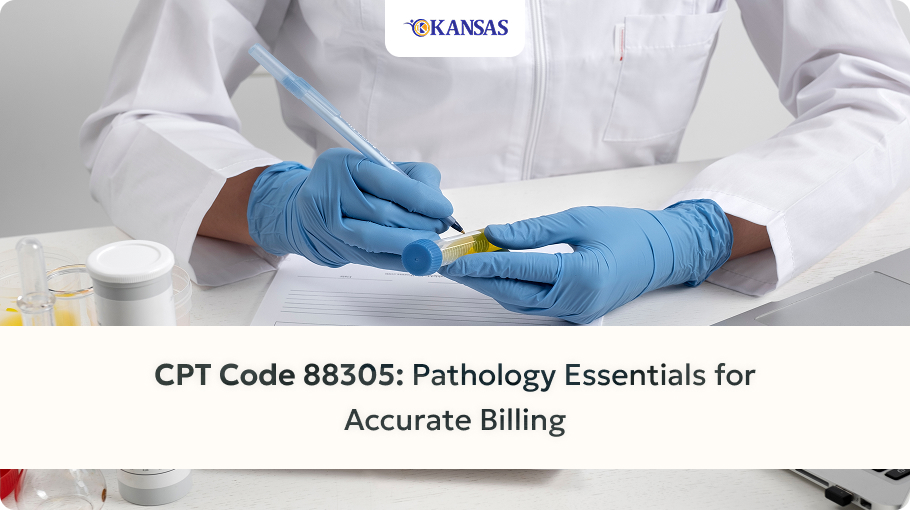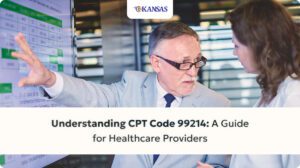In the United States, pathology billing most frequently uses CPT Code 88305. This code applies to Level IV surgical pathology services, specifically the gross and microscopic examination of tissue specimens. It ensures accuracy in diagnostic reporting, which directly influences reimbursement for pathology services.
Medical coders, laboratory billing teams, and pathologists must understand how to use CPT 88305 correctly. By following proper documentation, adhering to code section-based specimen types, and meeting payer criteria, they can ensure clean claims and reduce denial rates.
In this blog, we will explore everything from usage criteria and documentation standards to reimbursement strategies and common coding errors.
What is the CPT Code 88305?
CPT Code 88305 refers to a Level IV surgical pathology code used for the gross and microscopic examination of tissue samples. This code falls within the CPT surgical pathology category, which ranges from Level I (simpler examinations) to Level VI (more complex cases).
Under code 88305, a pathologist performs both a gross examination with the naked eye and a microscopic assessment to identify cellular variations, disease processes, or cancers. It is commonly applied to excisions and biopsies from various tissues and organs, including the skin, breast, prostate, gastrointestinal tract, and more.
The American Medical Association (AMA) classifies this code as representing intermediate-level pathology examinations. While CPT 88305 is less complex than codes 88307 or 88309, it still requires medical necessity, thorough documentation, and a formal diagnostic report to support billing and reimbursement.

Medicare Fee Schedule
The Medicare Physician Fee Schedule (MPFS) assigns a relative value to CPT 88305, which varies annually based on geographic adjustments and CMS updates. In recent years, reimbursement for 88305 has ranged from $70 to $90, depending on the location and whether it is billed under the physician or facility fee schedule.
CMS Payment Rule
According to the Centers for Medicare & Medicaid Services (CMS), billing CPT 88305 requires including proper diagnosis codes, CLIA certification, and supporting documentation that demonstrates medical necessity. Furthermore, CMS may reject claims if the specimen type does not match the complexity level assigned to 88305.
Commercial Payer Variations
Commercial payers may have varying payment rates and paperwork requirements, even though Medicare provides a baseline. To avoid underpayment or billing issues, it is critical to confirm payer-specific policies and maintain accurate specimen documentation. Some insurers may also bundle CPT 88305 with related services, such as collection or preparation.
NCCI Edits and Code Bundling
When billing CPT 88305, it is essential to monitor National Correct Coding Initiative (NCCI) edits. To prevent redundancy or incorrect billing, NCCI bundles this code with others, such as gross-only exams or specific lab procedures. Coders should apply modifiers, allowances, or unbundle codes only when clinically and legally justified.
Global Period Considerations
PCPT 88305 does not have a global period, meaning it is reimbursed independently of surgical procedures. However, it remains crucial to ensure that this code is not mistakenly bundled into the surgical charge, especially in hospital billing. Pathology services should be billed separately, with clear and accurate documentation and individual line-item charges.
Procedure and Examples of CPT Code 88305 in Use
Accurate billing of CPT Code 88305 begins with precise documentation from specimen collection through final reporting, which is crucial for the pathology workflow.
Let’s take a look at the typical process:
Pathology workflow for CPT 88305
- Specimen Collection: The Clinical Team collects the tissue specimen, such as a breast core sample or skin biopsy. Proper technique is essential to avoid damage or contamination.
- Specimen Labeling: The specimen is given a special identification label to guarantee precise tracking during the laboratory procedures. Proper labeling reduces errors and supports claim validation.
- Pathology Review: The gross examination is carried out by a pathologist who examines and describes the specimen visually. To find any abnormal or diseased cells, tissue sections are then cut and stained for microscopic examination.
- Documentation: The pathologist documents teh findings in a detailed report, which includes gross microscopic descriptions, diagnosis, and relevant clinical information. This documentation supports the medical necessity of CPT 88305 billing.
Real-World Billing Example
A skin biopsy is performed on a patient to assess a questionable lesion. The pathology team performs a gross and microscopic examination, which qualifies for CPT 88305.
CPT Code: 88305 Level IV surgical pathology, gross and microscopic examination.
ICD-10-CM Diagnosis Code: L98.9 (Disorder of the Skin and subcutaneous tissue, unspecified).
Medical coders ensure that CPT 88305 aligns with the relevant diagnosis to reflect the clinical justification for the biopsy accurately. They include clear documentation with the claim, reducing the risk of denials and speeding up reimbursement.
Diagnosis Codes that Justify CPT 88305
Several ICD-10 diagnostic codes provide the clinical justification for tissue investigation billed with CPT Code 88305. Accurately linking these diagnoses to 88305 is essential to support medical necessity and ensure appropriate payment.
Commonly Billed Diagnoses Include:
- D12.6 Benign neoplasm of Colon, rectum, anus, and anal canal (e.g, colorectal polyps)
- C50.9 Malignant neoplasms of breast, unspecified
- L98.9 Disorder of skin and subcutaneous tissue, unspecified (common for skin biopsies)
- K29.70 Gastritis, unspecified (for gastric biopsies)
- N40.0 Benign prostatic hyperplasia (prostate biopsies)
NCCI Rules for Diagnosis-Pathology Link
The National Correct Coding Initiative (NCCI) requires modifiers to prevent unbundling and improper code pairings. Coders should ensure that the diagnosis codes submitted support the use of 88305 and correspond to the examined specimen type. For example, billing 88305 with a diagnosis unrelated to pathology (e.g., general symptoms without tissue diagnosis) may trigger claim denials.
Billing and Coding Best Practices for CPT 88305
To maximize accurate reimbursement and compliance, follow these best practices:
- Documentation Tips: Make sure the pathology report contains thorough gross and microscopic descriptions, noting the size, clinical indication, and source of the material.
- Coding Compliance: Only assign CPT 88305 in cases where microscopic and gross examinations are conducted. Avoid billing if only gross examination occurs (use 88304 instead)
- Avoiding Upcoding/Downcoding: Avoid billing 88305 for less complex specimens (e.g., simple cysts) or more complex ones without documentation (which might require 88307 or 88309)..
- Modifiers: Use modifier -26 for the professional component (pathologist interpretation) and-TC for the technical component (laboratory processing) when billing separately.

Specimen Types Not Appropriate for 88305
- Simple cysts, fluids, or cellular specimens that require only cytopathology or gross examination usually do not qualify for 88305.
- CPT 88304 should be used for billing specimens that only require a gross examination and no microscopic processing.
- Highly complex or extensive specimens may require codes such as 88307 or 88309, which represent Level V and VI pathology exams.
When to Use 88304 or 88307 Instead
- CPT 88304 is used for Level III surgical pathology, usually involving gross examination only or microscopic evaluation without extensive analysis.
- CPT 88307 applies when the pathology examination is more detailed or complex than 88305, such as larger specimens or multiple tissue blocks needing thorough evaluation.
Payer-Specific Exclusionssome
Some commercial payers may not cover CPT 88305 or may bundle it with other pathology services. Always review each payer’s specific policies and medical necessity requirements. Failure to comply with these guidelines can lead to denials or reduced reimbursement.
Comparative Analysis: CPT Code 88305 vs. Related Pathology Codes
Understanding the differences between CPT 88305 and related surgical pathology codes helps coders select the most appropriate code based on specimen complexity and examination level.
| CPT Code | Description | Specimen Complexity | Typical Use |
| 88302 | Level I Surgical Pathology | Simple gross or microscopic exams | Very basic specimens, limited evaluation |
| 88304 | Level III surgical pathology | Gross examination only or minimal microscopic | Simple cysts or single tissue sections |
| 88305 | Level IV surgical pathology | Gross and microscopic examination | Most biopsies(skin,GI,breast,prostate) |
| 88307 | Level V surgical pathology | More complex specimens, multiple blocks | Larger tissue samples, excisions |
| 88309 | Level VI surgical pathology | Complex specimens requiring extensive analysis | Large resections, detailed evaluations |
Coding Decision Summary
- Use 88305 when the specimen requires both gross and microscopic evaluation, but is not sufficient enough to justify 88307 or 88309, use 88305.
- Choose 88304 if only a gross examination occurs.
- For multiple tissue specimens or high complexity, 88307 or 88309 applies.
- Avoid upcoding by carefully reviewing the pathology report and specimen details.
Best Practices for CPT Code 88305 Utilization
When used correctly, CPT 88305 ensures timely reimbursement, accurate invoicing, and regulatory compliance. Follow these recommended practices to streamline your pathology billing process:
- Conduct Regular Coding Audits
Inaccurate code assignments, gaps in documentation, and compliance issues can be identified through routine internal audits. CPT 88305 is used correctly when pathology results and billing claims are reviewed together.
- Provide Staff Training and Education
Educate coders, billers, and pathologists about payer-specific regulations, documentation standards, and the clinical criteria for 88305. Ongoing training reduces errors, increases confidence in coding decisions, and minimizes errors.
- Avoid Claim Denials and Rejections
Common causes of denials include insufficient documentation, incorrect diagnosis-code pairing, or use of the wrong CPT code level. Address these issues proactively by verifying specimen types, pathology complexity, and compliance with payer policies before claim submission.
Pathology providers and billing teams can reduce revenue loss and improve CPT 88305 claim accuracy by following these guidelines.

Overview of Surgical Pathology CPT Codes
Surgical pathology CPT codes range from Level I (basic exams) to Level VI (highly complex cases), organized by the complexity of the examination. Each code reflects the extent of microscopic and gross examination performed on tissue samples. As a Level IV code, CPT 88305 represents an intermediate complexity level and is commonly used for a wide variety of clinical specimens.
How Accurate CPT Coding Impacts Revenue Cycle
Accurate coding supports the revenue cycle by ensuring appropriate reimbursement when CPT codes correctly reflect the complexity and scope of pathology services. In contrast, coding errors or mismatched documentation can increase delays, lead to denials, and negatively impact cash flow.
Role in Patient Diagnosis and Care Coordination
Accurate CPT coding also impacts patient care by ensuring that pathology findings are correctly documented and billed. This supports timely diagnosis, efficient treatment planning, and effective interdisciplinary communication. Pathology codes like CPT 88305 highlight the critical role of pathology services within the broader healthcare system.
Key Points to Remember
Here are some key points to remember while using the CPT 88305
- Correct Documentation: To support CPT 33805 billing, make sure that the gross and microscopic descriptions are clear, the source, and the clinical indication.
- Diagnosis-Code Pairing: Always link CPT 88305 with appropriate ICD-10 codes that justify medical source and clinical indication to support CPT 88305 billing.
- Reimbursement Nuances: To avoid denials and optimize reimbursement, be aware of CMS regulations, commercial payer variations, Medicare fee schedules, and NCCI modifications.
- Appropriate Code Selection: Use CPT 88305 only for Level IV surgical pathology involving both gross and microscopic examination; consider alternatives like 88304 or 88307 when applicable.
- Modifier Use: Apply modifier -26 for professional component and -TC for technical component as needed.
- Compliance and Audits: Regular coding audits and staff training help maintain coding accuracy and reduce claim rejections.
Conclusion
For accurate pathology billing, timely reimbursement, and improved patient care through precise diagnosis, CPT Code 88305 must be used correctly. By understanding its proper use, documentation requirements, and payer guidelines, medical coders, billers, and pathology providers can reduce claim denials and maximize reimbursement.
Need Help Coding CPT 88305 or navigating Pathology Billing Rules?
Feel free to contact Kansas Medical Billing. Our team of pathology billing experts is here to assist you.
Contact us today to streamline your billing process and ensure accurate claims every time.
Frequently Asked Questions (FAQ) About CPT Code 88305
Q1: What is CPT code 88305 used for?
CPT 88305 applies to Level IV surgical pathology services, covering both gross and microscopic examination of tissue specimens, including biopsies from the skin, breast, gastrointestinal tract, and other organs.
Q2: What is the difference between CPT 88305 and 88307?
CPT 88305 covers intermediate-level pathology examinations involving gross and microscopic evaluation of specimens with moderate complexity. In contrast, CPT 88307 is used for more complex specimens that require detailed analysis, often involving multiple tissue blocks or larger, more intricate samples.
Q3: How much does Medicare reimburse CPT 88305?
Medicare reimbursement for CPT 88305 typically ranges from $70 to $90, depending on geographic location and specific Medicare fee schedules. Exact rates vary annually and by region.
Q4: What documentation is needed for CPT 88305?
Documentation must include detailed gross and microscopic descriptions of the specimen, the specimen source, clinical indications, and a formal diagnostic report. Thorough documentation supports medical necessity and ensures billing compliance.
Q5: Can CPT 88305 be billed multiple times per patient?
Yes, if multiple specimens from different sites are collected, each can be billed separately with the proper modifiers and documentation.
Q6: What happens if I bill CPT 88305 for a simple fluid sample?
That would likely trigger a denial. CPT 88305 is not meant for cytopathology or fluid-only exams. Use a more appropriate code like 88104 or 88304 instead.



